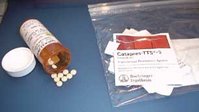Catapres
Clonidine is a centrally acting antihypertensive (to lower high blood pressure) agent, used mainly for this purpose in the past. It has found new uses, including treatment of some types of neuropathic pain, opioid detoxification, and, off-label, to counter the side effects of stimulant medication such as Methylphenidate. It is also increasingly becoming a more accepted alternative to fight insomnia as the drug is less addictive than most prescription sleep aids. more...
Because of the above effects, Clonidine is increasingly used in conjunction with stimulants to treat attention-deficit hyperactivity disorder ADHD where it's given late afternoon and/or evening for sleep and because it sometimes helps moderate ADHD associated impulsive and oppositional behavior and may reduce tics ref.
Mechanism of action
Clonidine is a centrally-acting alpha-2 agonist. It selectively stimulates receptors in the brain that monitor catecholamine levels in the blood. These receptors close a feedback loop that begins with descending sympathetic nerves from the brain that control the production of catecholamines (epinephrine, also known as adrenaline, and norepinephrine) in the adrenal medulla. By fooling the brain into believing that catecholamine levels are higher than they really are, clonidine causes the brain to reduce its signals to the adrenal medulla, which in turn lowers catecholamine production and blood levels. The result is a lowered heart rate and blood pressure, with side effects of dry mouth and fatigue.
An analogy would be the lowering the temperature of a house by holding a lit match under the thermostat connected to the furnace.
Administration
Clonidine is typically available as tablets (Catapres®, Dixarit®), as a transdermal patch (Catapres-TTS®), or as an injectable form to be given epidurally, directly to the central nervous system.
Read more at Wikipedia.org



